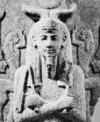- Ramses III
-
1198-1167 B.C., king of ancient Egypt.
* * *
died 1156 BCKing of ancient Egypt, 1187–56 BC.Son of Setnakht, the founder of Egypt's 20th dynasty, he fought off Libyan invaders in the fifth year of his reign and the Sea Peoples (a conglomeration of migrating peoples from Anatolia and the Mediterranean Sea region) two years later. After another conflict with the Libyans, he achieved a lasting peace. He then reorganized society into classes grouped by occupation and resumed temple building. He encouraged trade and industry, and the country prospered. A delay in sending monthly rations to temple builders in Thebes с 1158 BC resulted in the world's first recorded labour dispute. Ramses III, detail of the lid of a granite sarcophagus, about 1187–56 BC; in the ...By courtesy of the Fitzwilliam Museum, Cambridge
Ramses III, detail of the lid of a granite sarcophagus, about 1187–56 BC; in the ...By courtesy of the Fitzwilliam Museum, Cambridge* * *
▪ king of Egyptdied 1156 BCE, Thebes, Egyptking of ancient Egypt (Egypt, ancient) (reigned 1187–56 BCE) who defended his country against foreign invasion in three great wars, thus ensuring tranquillity during much of his reign. In his final years, however, he faced internal disturbances and an attempted coup d'état.Son of Setnakht (reigned 1190–87 BCE), founder of the 20th dynasty (Egypt, ancient) (1190–1075 BCE), Ramses found Egypt upon his accession only recently recovered from the unsettled political conditions that had plagued the land at the end of the previous dynasty. In the fifth year of his reign, a coalition of Libyan tribes invaded the western Nile River delta on the pretext that the pharaoh had interfered in their chief's succession. The Libyans had in fact encroached upon Egyptian lands, a perennial problem during the 19th and 20th dynasties, and were soundly defeated in a battle in the western delta.After two years of peace, another, more dangerous coalition, the Sea People, a conglomeration of migrating peoples from Asia Minor and the Mediterranean islands who had previously destroyed the powerful Hittite empire in Asia Minor and devastated Syria, advanced against Egypt by land and by sea. Ramses' land army checked the enemy's advance in southernmost Palestine, and the hostile ships were trapped after being lured into the waterways of the delta. Egypt averted conquest by the northerners, but two of the invading peoples settled on the coast of Palestine, between Gaza and Mount Carmel. The attempted invasion ended Egyptian pretensions to a Syro-Palestinian hegemony.Two more years of peace ensued, but in Ramses' 11th year a new coalition of Libyan tribes infiltrated the western delta. Compelled to wage yet another war, he defeated the Libyans after capturing their chief. After this final conflict, Ramses was able to finish his great funerary temple, palace, and town complex at Madīnat Habu, in western Thebes. He also built additions to Karnak, the great Theban temple complex, and encouraged trade and industry, dispatching a seaborne trading expedition to Punt, a land on the Somali coast of Africa, and exploiting the copper mines at Sinai (Sinai Peninsula) and probably also the gold mines of Nubia, Egypt's province to the south.After a prosperous middle reign, administrative difficulties and conspiracy troubled Ramses' last years. About year 28 of the king's reign, the vizier of Lower Egypt was ousted because of corruption. A year later the workers employed on the royal tombs at Thebes went on strike because of delay in the delivery of their monthly rations. Only the intervention of the Upper Egyptian (Upper Egypt) vizier, who had assumed responsibility for the whole country, ended the work stoppage.Toward the end of Ramses' reign, one of his secondary wives, seeking to place her son on the throne, plotted to assassinate the king. The plan was somehow betrayed and probably foiled, as the plotters were successfully brought to trial. The king may have died as a result of the plot or soon afterward, but documents contain no information about the year of the conspiracy, and the king's mummy displays no wounds. Ramses died at Thebes in the 32nd year of his reign and was succeeded by the crown prince Ramses IV.* * *
Universalium. 2010.
